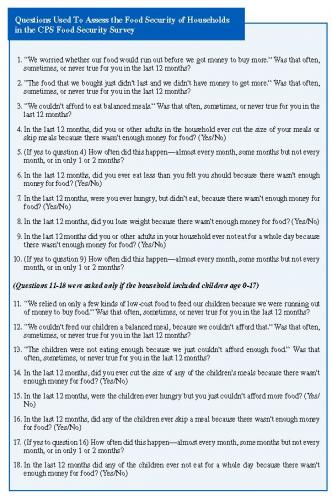The U.S.D.A.’s Economic Research Service monitors the extent and severity of food insecurity in U.S. households through a supplement to the Current Population Survey. Responses to a series of 18 questions are used to determine whether a household is food insecure.
 Households are considered to have have food security
when they report two or less indications of food access problems
or limitations.
Households are considered to have have food security
when they report two or less indications of food access problems
or limitations.
Household are food insecure when they report three or more such conditions. Food insecure household are further classified as either having low food security or very low food security.
In 2023, 18 million households or 13.5% were food insecure at some time during the year due to lack of resources.
 While over 86% of all households are not food insecure,
only about 62.7% of poor households are food secure. About
8.4% of all households and 21.7% or poor household had low food
security, and 5.1% of all households (15.6% of poor households)
had very low food security.
While over 86% of all households are not food insecure,
only about 62.7% of poor households are food secure. About
8.4% of all households and 21.7% or poor household had low food
security, and 5.1% of all households (15.6% of poor households)
had very low food security.
In addition the rates of food insecurity for the following groups were higher than the national average of 13.5%:
Source:
Matthew P. Rabbitt, Madeline Reed-Jones, Laura J. Hales, and
Michael P. Burke.Household
Food Security in the United States in 2023. U.S. Economic
Research Service. Economic Research Report No. (ERR-337), 2024.
Table S-2: Number of individuals by food security status of U.S.
households and selected household characteristics, 2023.
(Supplemental PDF)
Accessed 12/17/2025
© Center for Poverty and Inequality Research
All Rights Reserved.
